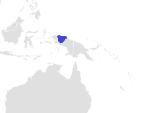Hemiscyllium galei
| Hemiscyllium galei | |
|---|---|
| Scientific classification | |
| Kingdom: | Animalia |
| Subkingdom: | Eumetazoa |
| Phylum: | Chordata |
| Subphylum: | Vertebrata |
| Infraphylum: | Gnathostomata |
| Class: | Chondrichthyes |
| Subclass: | Elasmobranchii |
| Superorder: | Selachimorpha |
| Order: | Orectolobiformes |
| Family: | Hemiscylliidae |
| Genus: | Hemiscyllium |
| Species: | H. galei |
| Binomial name | |
| Hemiscyllium galei G. R. Allen & Erdmann, 2008[1] | |
 | |
| Range of the Cenderwasih epaulette shark | |
Hemiscyllium galei (Cenderwasih epaulette shark) is a species of bamboo shark in the family Hemiscylliidae. Together with H. henryi, it was only scientifically described in 2008 by Gerald R. Allen and Mark V. Erdmann.[1][2] At present, H. galei is only known from depths of 2 to 4 metres (6 ft 7 in to 13 ft 1 in) at reefs in the Cenderawasih Bay in West Papua, Indonesia.[1] The largest known specimen was 56.8 centimetres (22.4 in) long.[1] It can be separated from its relatives (e.g., H. freycineti) by the combination of seven relatively large dark spots along the side of the body (between the abdomen and tail-base), white markings on the edge of its dark dorsal saddles and other scattered white spots on the upper side.[1]
References
External links
- Michael, S. (May 13, 2008). New Epaulette Walking Sharks! Retrieved August 30, 2011.
This article is issued from Wikipedia - version of the 4/24/2015. The text is available under the Creative Commons Attribution/Share Alike but additional terms may apply for the media files.
